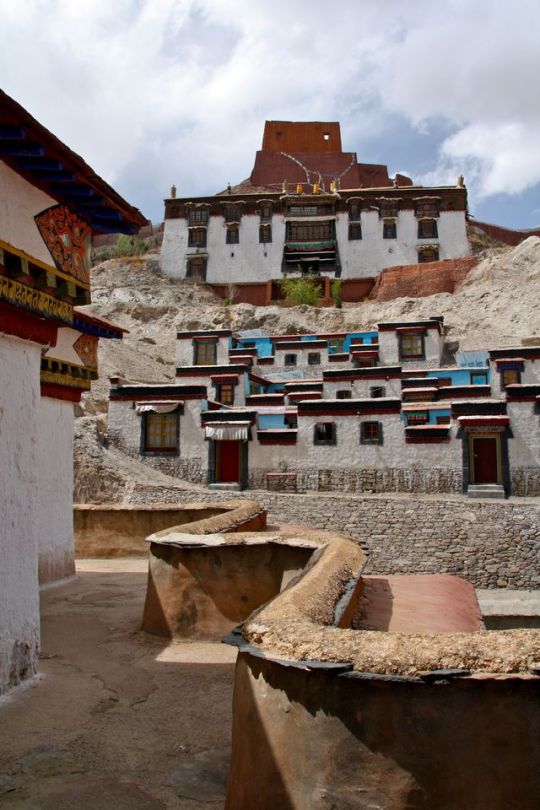Intro to East Asian Civ: Tibet Final Project for Natalie, Melanie, Elena, and Tyra
Don't wanna be here? Send us removal request.
Photo
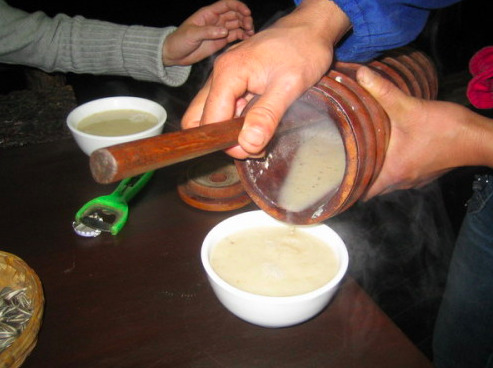
Our last recipe is Tibetan Butter Tea, or Po Cha, which is a very common beverage in Tibet, served several times a day. It is especially common in the high altitude locations in Tibet where it is especially cold and the air is very thin. As Melanie and Elena mentioned, the tea keeps you warm and gives you energy as a result of its high fat, electrolyte and calorie content, which is necessary to stay active in such harsh breathing conditions. Additionally, in Tibetan medicine, the combination of butter and tea is said to give a mind-body balance that can’t be achieved when the two foods are consumed individually. Po Cha is very salty unlike what one would usually call a tea thus most tourists/non-Tibetans don’t like it initially just because it isn’t what they were expecting. It is an acquired taste that most Tibetans have come to love, but as mentioned above it also has its practical uses. Yak butter is used and can be relatively expensive in Tibet so some Tibetans will drink a simple yak milk tea instead. Whether Tibetan butter tea or salty milk tea is used usually depends on the region. Nomadic regions such as in Amdo tend to be poorer and thus lean more toward yak milk tea. As they depend on the products of their yak and sheep to make a living, it is more beneficial to sell their yak butter rather than use it for personal uses. Additionally, the yak butter they don’t sell is usually used to made tsampa, a very common food in Tibet that is a high calorie paste made from yak butter, barley paste, curds and black tea.
As butter tea is the more traditional Tibetan drink, below is the recipe we used to make butter tea!
Tibetan Butter Tea (Po Cha):
RECIPE:
4 cups of water
Plain black tea bags
¼ teaspoon tea bags
2 tablespoons butter
⅓ cup half and half milk
DIRECTIONS:
1. Boil four cups of water
2. Put two tea bag in the water and let steep while the water is boiling for a couple of minutes.
3. Add a quarter teaspoon of salt.
4. Remove tea bags
5. Add a third to a half cup of milk or a teaspoon of milk powder
6. Remove the tea mixture from the stove and put into a blender with two tablespoon of butter for 2 to 3 minutes.
We (Nat and Tyra) personally did not like this drink too much, as most non-Tibetans don’t. It’s definitely a taste you really have to get used to. Also, given how heavy it is, it was hard to just drink it straight by itself. We feel like its very difficult to truly appreciate it when it doesn’t have the practical use to us that it does in Tibet. We found it very interesting that it’s called a tea, as usually teas are a lot sweeter and lighter. This drink actually reminded us a lot of a soup that you would eat with something else, rather than something you drink straight by itself. In Tibet, when necessary for its physical benefits, Po Cha is drunk as a beverage but when served on a regular based it is usually served with tsampa which can be dipped in the butter tea.
1 note
·
View note
Photo

I (Tyra) personally really liked the dresil as I love sweet foods and in the dresil, the raisins and sugar together made it very sweet. Also, the butter was a nice touch to really pull it all together and make it a bit more substantial of a meal. It reminded us a lot of sticky rice, or glutinous rice, which is a very popular dessert in many different countries in Southeast and East Asia, that is very sweet and sticky, as its name implies, as a result of the type of rice it is made from. However, this type of rice doesn’t grow in Tibet. Thus, in some ways Dresil can be seen as Tibet’s own form of Tibet sticky rice!
0 notes
Photo
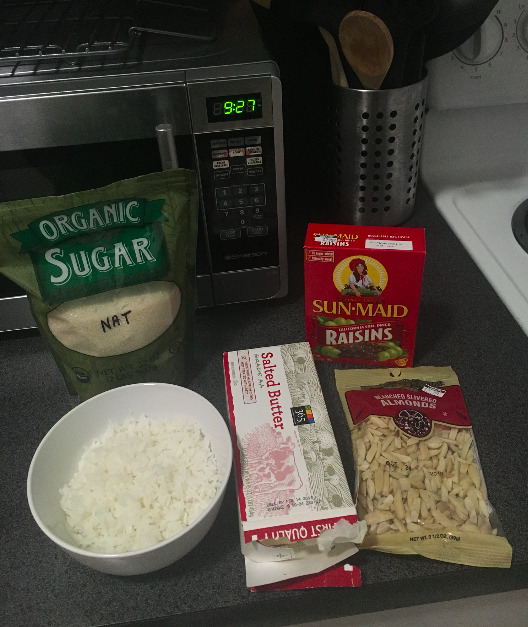
Dresil is a sweet dish usually only served on special occasions such as weddings and Buddhist holidays, however its main use in Tibet is on Losar, the Tibetan New Year. In Central Tibet and some other areas, people will eat it first thing in the morning on the first day of the New Year accompanied by changkol and butter tea which Elena and Melanie tried at Cafe Himalayas. Nat and I will talk about this tea for our next recipe!
In traditional Tibetan dresil, they use butter from a dri, or female yak, and droma, which is a small root grown in Tibet that tastes very similar to a sweet potato. However, for our purposes we just used cow’s milk and omitted the droma, adding raisins and almonds instead.
RECIPE:
2 cups of rice
6 tablespoons of butter
½ cup cashew nuts
1 cup raisins
¼ cup of sugar
DIRECTIONS:
1. Cook the rice
2. Melt the butter
3. Mix all the ingredients together
This is a quick and easy recipe that can be made easily; the main time component of this dessert is making the ingredients themselves. When making traditional dresil, on top of cooking the rice and obtaining the expensive yak butter, the droma must be boiled in water for 35-40 minutes, drained and rinsed in order to remove the bacterial and soil contained in the root.
0 notes
Photo

The final product! Tibetan Sangha Bhaley, Sweet Tea and Dresil which will be featured in the next post.
0 notes
Text
As Tibetan Momos, tsampa and many other foods were mentioned many times in class, the four of us (Melanie, Natalie, Tyra and Elena) decided to try some out in a restaurant and attempt to cook them as well. So Melanie and I (Elena) decided to visit Cafe Himalaya and experienced for our first time real Tibetan food there where the interior design and decoration also gave off a traditional Tibetan vibe. Natalie and Tyra found a few common Tibetan dishes recipes and tried to cook them on their own. We created this Tumblr together to record our exploration of Tibetan food-- both tasting and cooking!
0 notes
Photo
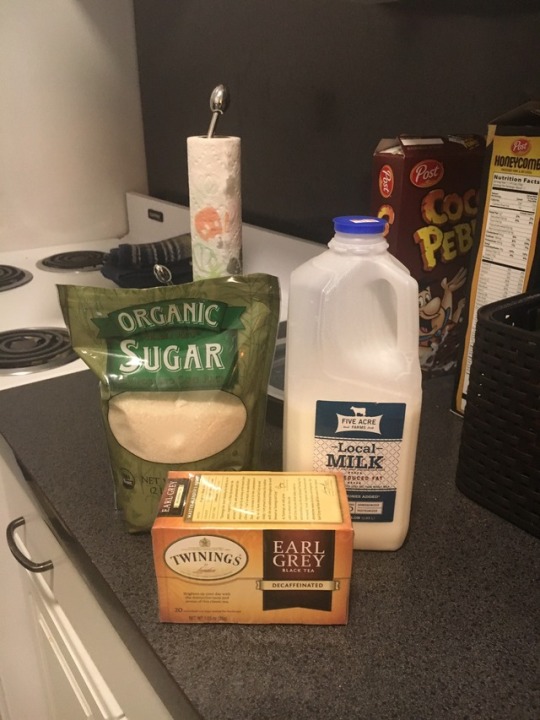
We decided to make a traditional beverage to go along with our food choices. For Tibetans, sweet tea is just like their coffee. It’s the top choice drink as they enjoy the leisurely life with their friends in tea houses across Tibet. Normally, Tibetans will order sweet tea together with Tibetan noodles. Though making noodles was a bit outside of our wheelhouse, we definitely got the tea recipe down pat. This is exactly how Natalie prepared her tea before the project since she doesn’t drink coffee. It was simple and delicious!
RECIPE: Black tea
Milk
Sugar
DIRECTIONS:
1.Boil the black tea
2.Mix milk with tea
3.Add sugar into the tea and boil again for around 5-6 mins.
0 notes
Photo
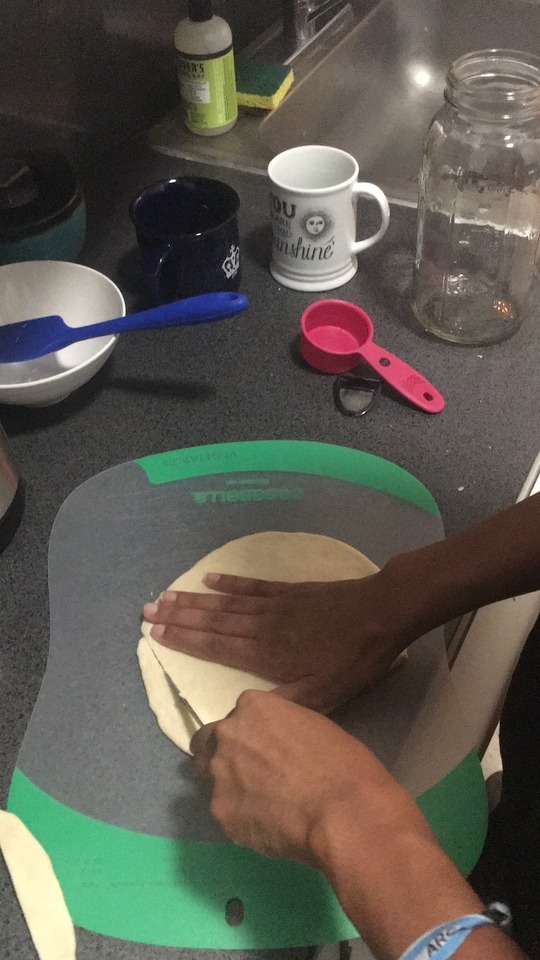

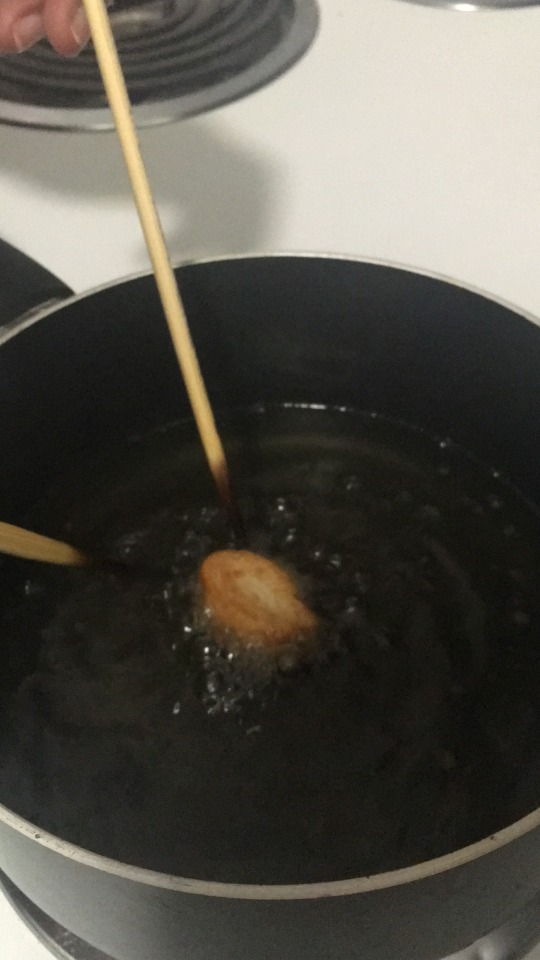
The Sangha Bhaley at three different stages. it is very important to make the layers paper thin— something we weren’t quite able to achieve. However, consider the dough was hand rolled, we thought we did a pretty good job. It tasted good!
0 notes
Photo

The first thing we decided to make was a traditional Tibetan bread called the Sangha Bhaley. A sangha bhaley is a particular type of khapsey, which is a Tibetan snack or pastry made of whole flour, sugar or salt and butter/ghee or oil. In this case, we sprinkled the pastry with sugar at the end of the process to make it more of a dessert pastry. Being that neither Tyra nor Natalie are chefs (and certainly don’t own a noodle maker), the desired thinness was not achieved. However, the taste was just as expected. We liked the simplicity of the recipe, because it seemed like something that we could make again. It was very reminiscent of a Tibetan spin on a beignet or fry bread.
RECIPE:
3 cups regular white Flour Approx 1 cup boiling hot water Shortening (for deep frying) Sugar
DIRECTIONS:
1.Put the flour in a large bowl, slowly add hot boiling water stirring with a ladle mixing in the water to form a dough. Once the dough is formed, slowly handle it with you hands – it’ll be hot but gently start adding a little pressure and knead for a few minutes until it is the consistency of momo dough – not too dry but smooth texture. Cover and let sit.
2.You need a cooking utensil for deep frying – Add a decent amount of the shortening into it and put it over a medium flame. It is good if the oil for deep frying has about 3” depth. The oil needs to be very hot.
3.Divide your dough into four portions. There are two ways to do it from here – with the extra help of a noodle maker or manually on a kneading board.
4.Manually on a Kneading Board: Roll out the dough as big and thin as you can make it – lightly dusting the surface with flour helps if the dough sticks. Roll the dough till it’s about 22 inches long to about half the width. Slice of the rough edges along the side to make a long rectangle.
5.Oil generously with the melted shortening leaving about 1” at the top oil free. Beginning from the bottom end, near you, gently fold over the tip of the edge and start rolling the dough all the way to the top into a long narrow tube shape.
6.Slice of the rough edges of the rolled up dough. Beginning from one end, cut ½” size slices from the rolled up dough. Each 1/2” slice will make one Sangha Bhaley. Pull once aside, gently flatten the top with your index finger, then flatten it will a rolling pin to make it about 2”x3 ½” flat shape. Make a number of these and then you are ready for frying.
7.Heat the oil until it is very hot almost smoking. The cookies have to be fried one at a time … use a pair of long chopsticks – maneuvering the cookie as you slip it into the hot oil. Press down on the two side edges, allowing the cookie to expand in the middle. Flip it over and do the same. Then turn it sideways, and hold it with the chopsticks, allowing the oil to get in between the layers in the middle. Its ready when its golden brown. Take it out, and leave it standing on the side. Its important to let it sit near the stove where its warm, so that the oil continues to drip down. If left in a place further from the stove, the oil may harden and not drip completely.
8.Lastly, it’s time to sugar the cookie. This is done only when the fried cookies are completely cooled down. In fact, it is good to store the cookies without sugar, adding the sugar only when its time to eat or share. Each Sangha Bhaley is carefully and generously sprinkled with sugar – on both sides and in between. Now it is ready to eat!
0 notes
Photo
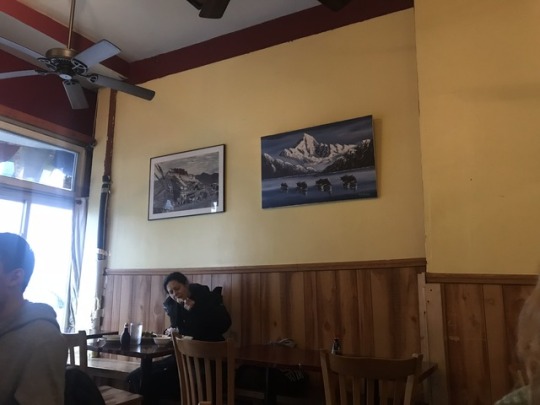
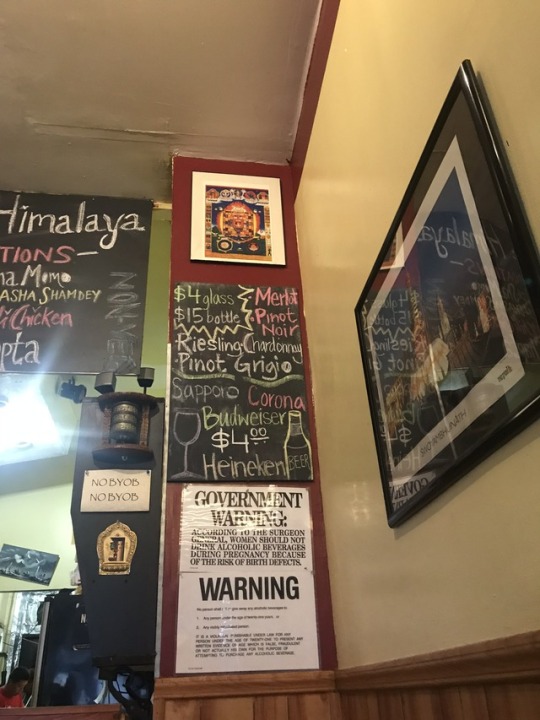


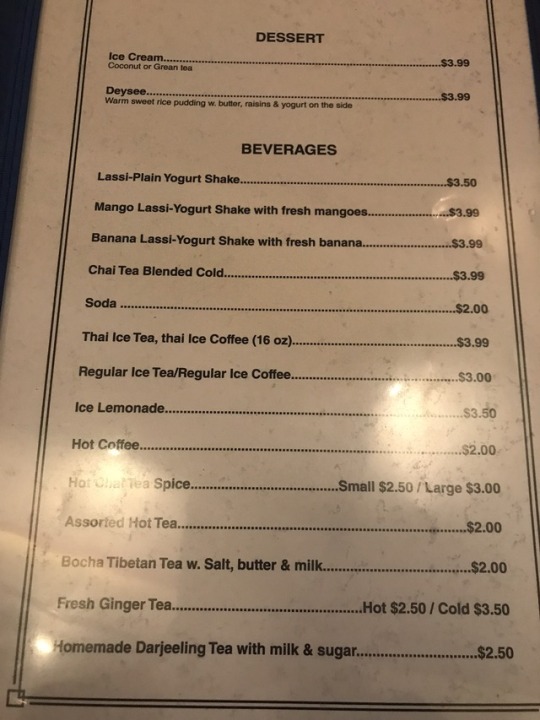
Here’re pictures of our menu and the interior design of the restaurant cafe himalaya!
0 notes
Photo


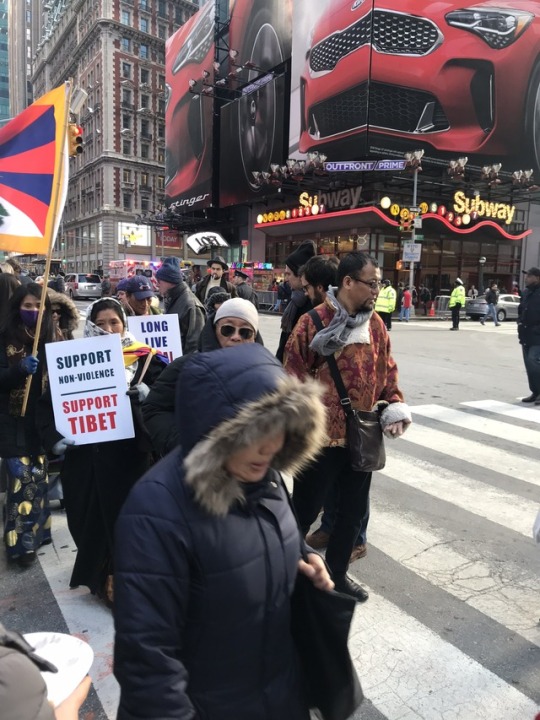
As I was walking on the street by Times Square last Sunday, I saw a huge pack of people marching down Broadway with flags of Tibet and signs that say “Support Tibet” “Support Peace” “Support Non-violence”. Most of the protestors were middle aged to old people and they were mostly wearing traditional Tibetan clothings that indicated their cultural identity. It wasn’t a particularly loud or aggressive crowd of protestors unlike most manifestations I’ve encountered. Perhaps it’s also a good way to demonstrate the non-violent way to voicing their discontent.
0 notes
Photo
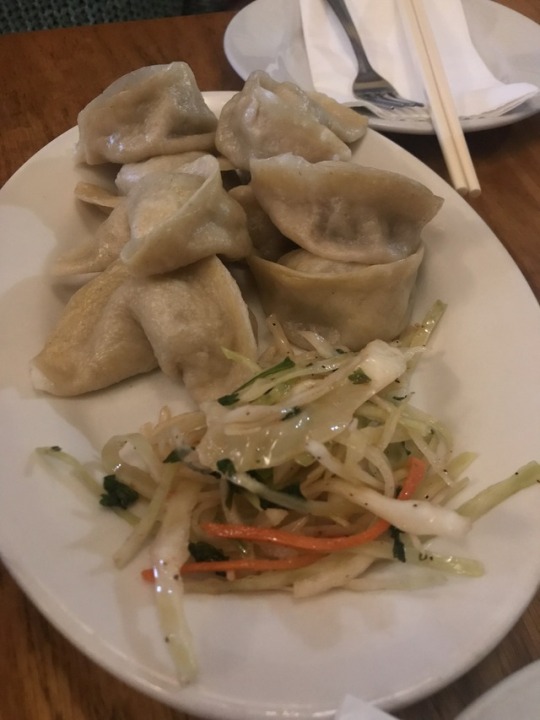
Our waitress recommended that we order momos, as they are an extremely common dish in Tibet. When Elena posted a picture of me on her instagram story, her friend from Bhutan, a neighboring country of Tibet commented that we had to get the momos. We ordered steamed momos with chicken and vegetables, hoping this would give us the most authentic experience of this classic Tibetan street food. They were served with a spicy sauce that Elena and I both enjoyed as it complemented the flavors of the filling. Coming from an American perspective, I found momos to be very different from any of the dumplings I’ve eaten in the US (granted I’ve never been to Asia and experienced traditional dumplings). The dough skin of the dumpling was much thinner than most Chinese dumplings, which I later learned is because Momos are made with wheat or millet flour rather than white flour. I also found the inside to be very oily and even noticed the filling of the dumpling spill out once the skin was broken much like the Chinese Guan tang bao (soup dumplings). Upon further research, I learned that momos are most similar to Chinese Baozi dumplings. Overall we really enjoyed trying this traditional Tibetan dish and I personally feel that I now understand why they are so popular among Tibetans!
0 notes
Photo

The Chasha Shamdey was perhaps our favorite dish especially with the rice they provided. The rice was quite different from what I had in China before because the shape is not round; it looks rather pointy on both ends and thin. The taste of the rice was also great-- not too chewy or soft and had a nice scent to it that normal rice doesn’t have. The curry chicken dish tasted similar to Thai or Indian curry. It goes particularly well with the rice. We also noticed the serving size wasn’t big and we wondered if it’s common in Tibetan cuisine or just in the adapted version in New York. The chicken itself is well cooked and there was also potatoes in the curry which taste great cooked with curry as it absorbs the sauce.
0 notes
Photo
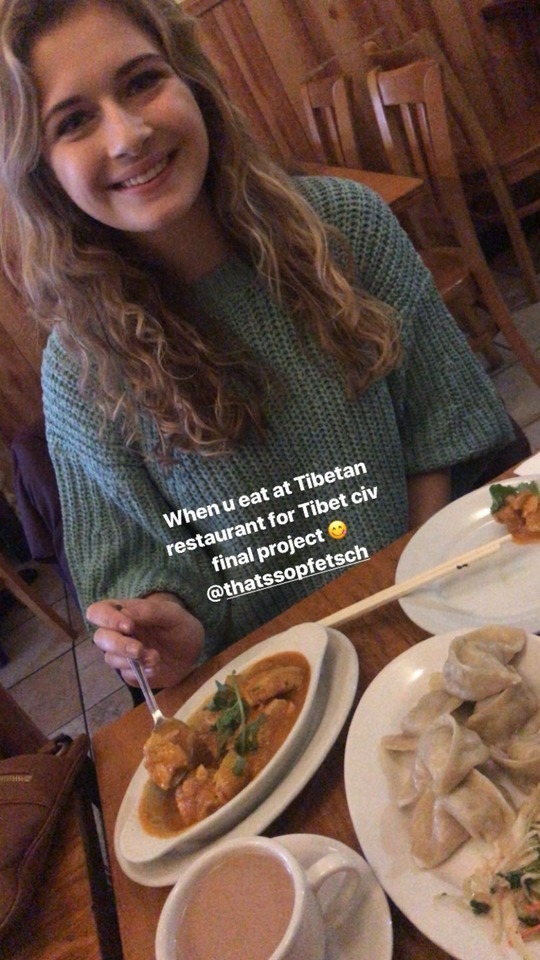
The Tibetan tea tasted interesting-- in a sense it’s similar to the normal milk tea but it’s also salty and buttery. I’ve tasted something similar in Xinjiang (Aletai area) in the mountains which has similar altitude and landscape as Tibet and also located in Northwestern Xinjiang. I imagine for people who live in cold and harsh environment in the mountains especially, this warm, high-calorie milk tea with a lot of nutrition would be a great idea. After the tea was left on the table for a while, the top solidified -- mostly the butter probably. The taste was rather thick and very salty. And we were wondering why Tibetans enjoy the salty type of milk tea rather than sugary and whether it perhaps compliments the taste of Tibetan cuisine.
0 notes
Photo

Melanie and Elena went to Cafe Himalaya on a snow day! And they tasted Sha Momo (traditional Tibetan dish steamed stuffed with beef & herbs served with salad),traditional Bocha Tibetan tea with salt butter and milk and Chasha Shamdey (a Himalayan style chicken curry marinated in homemade yogurt & spices served w. Basmati rice).
0 notes
Photo


Tiny Thak Thok Monastery, built around a sacred cave where the famous Buddhist saint Padmasambhava (Guru Rinpoche) is said to have stayed on his journey to Tibet from India.
4K notes
·
View notes
